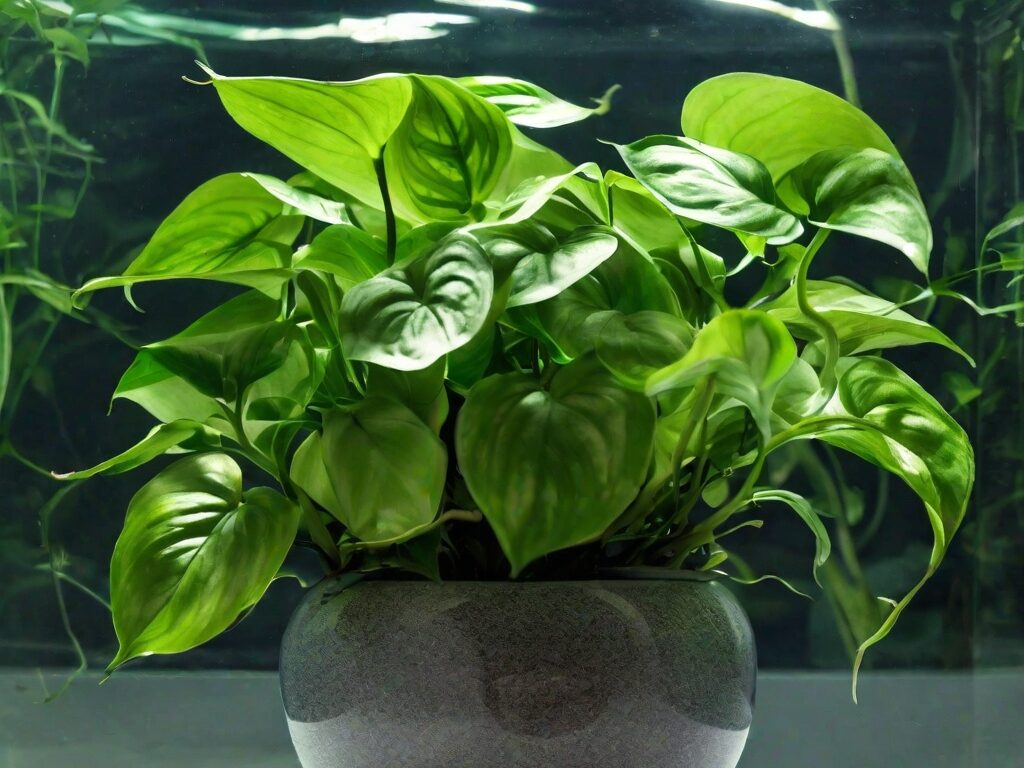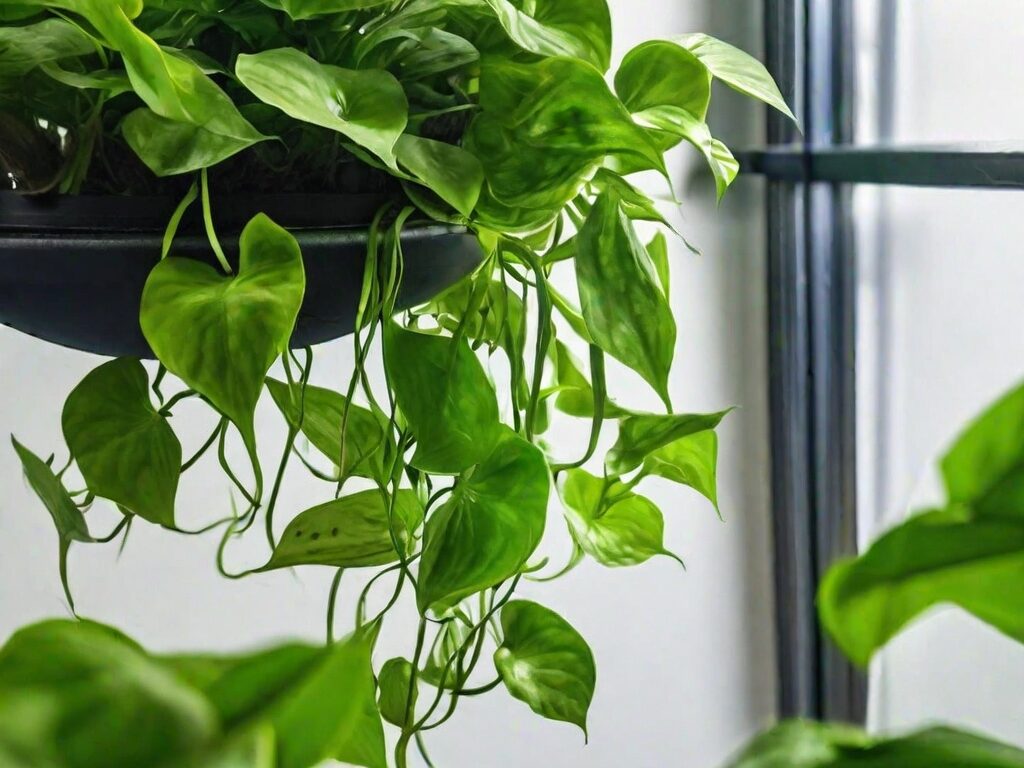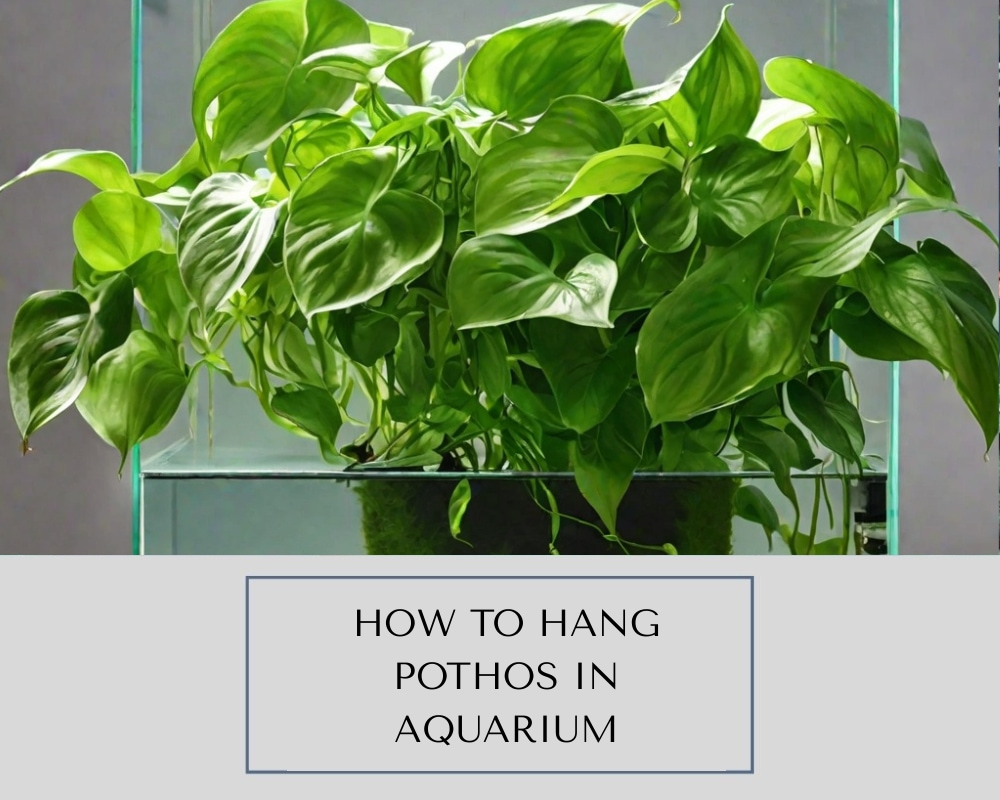Do you want to add some greenery and freshness to your aquarium? Do you want to improve the water quality and oxygen level for your fish and plants? Do you want to create a natural and beautiful look for your tank? If you answered yes to any of these questions, then you might want to try hanging pothos in an aquarium. Pothos is a type of vine plant that can grow in water and soil. It has many benefits for aquariums, such as filtering the water, providing oxygen, reducing algae growth, and creating a natural look. In this article, we will show you how to hang pothos in an aquarium and what benefits it can bring to your fish and plants.
Pothos is a plant that can make your aquarium look amazing and healthy. It is a vine plant that can grow in both water and soil. It has green leaves that can purify the air and the water. It can also produce oxygen and prevent algae from growing in your tank. Pothos can also make your tank look more natural and relaxing. But how do you hang pothos in an aquarium? There are different ways to do it, depending on your preference and the size and shape of your tank. In this article, we will teach you how to hang pothos in the aquarium and what advantages it can offer to your fish and plants.
What is Pothos and Why Use It in Aquarium?
Pothos is a type of vine plant that belongs to the Araceae family. It is native to Southeast Asia and Australia, but it can grow in almost any climate and condition. Pothos is easy to propagate and care for, making it a great choice for beginners and experts alike.
Pothos has many benefits for aquariums, such as:
- Filtering the water: Pothos can absorb ammonia, nitrite, nitrate, phosphate, and other harmful substances from the water, improving the water quality and reducing the need for frequent water changes.
- Providing oxygen: Pothos can produce oxygen through photosynthesis, which can increase the dissolved oxygen level in the water and benefit the fish and plants.
- Reducing algae growth: Pothos can compete with algae for nutrients and light, which can prevent or reduce algae growth in the aquarium.
- Creating a natural look: Pothos can add a touch of greenery and nature to the aquarium, creating a more aesthetically pleasing and relaxing environment.

How to Prepare Pothos for Aquarium Use
Before you hang pothos in the aquarium, you need to prepare them properly. Here are the steps to follow:
- Choose healthy pothos plants: You can buy pothos plants from nurseries, garden centers, or online stores. Make sure the plants are healthy, with no signs of pests, diseases, or damage. You can also use cuttings from existing pothos plants, as long as they have at least one node (the bump on the stem where leaves grow).
- Rinse the plants thoroughly: You need to rinse the plants with clean water to remove any dirt, chemicals, or pathogens that might harm your aquarium. You can also use a mild bleach solution (one part bleach to 19 parts water) to disinfect the plants, but make sure to rinse them well afterwards.
- Remove the soil from the roots: If you bought pothos plants in pots, you need to remove the soil from the roots gently. You can use your fingers, a fork, or a hose to loosen the soil and wash it away. You can also trim any dead or damaged roots with scissors or a knife.
- Acclimate the plants to the water: You need to acclimate the plants to the water temperature and chemistry of your aquarium. You can do this by placing the plants in a bucket or container with some aquarium water and letting them sit for a few hours or days. You can also add some aquarium salt or de-chlorinator to the water to help the plants adjust.
How to Hang Pothos in Aquarium
Pothos is a plant that can grow in water. You can put it in your aquarium to make it look nice and clean. But how do you hang pothos in an aquarium? There are different ways to do it. You can choose the one that suits your tank and your style. Here are some of the ways you can try:
1. Using suction cups
Suction cups are small plastic cups that can stick to the glass of your tank. They have hooks or clips that you can use to hold the pothos stems. You can buy suction cups from pet stores or online shops. To use them, you need to do these steps:
- Clean the suction cups with water and soap. Make sure they are not dirty or oily.
- Stick the suction cups to the side or the back of your tank. Choose a spot that has enough light and space for the pothos to grow.
- Attach the pothos stems to the hooks or clips of the suction cups. Make sure the stems are long enough to reach the top of the water. You can also use a fishing line or a thread to tie the stems to the suction cups if they are loose.
2. Using a lid or a cover
A lid or a cover is something that you put on top of your tank to keep the water from evaporating or splashing. It can also protect your fish from jumping out or your cat from getting in. Some lids or covers have holes or gaps that you can use to put the pothos stems through. You can buy lids or covers from pet stores or online shops, or you can make your own with plastic, wood, or metal. To use them, you need to do these steps:
- Find a lid or a cover that fits your tank well and has holes or gaps that are big enough for the pothos’ stems. Make sure the lid or the cover does not block the light or the air that your fish and plants need.
- Put the lid or the cover on top of your tank. Make sure it is secure and stable.
- Insert the pothos stems through the holes or gaps of the lid or the cover. Make sure the stems are long enough to touch the water. You can also use a mesh or a net to make a platform for the pothos to rest on.
3. Using a hanger or a stand
A hanger or a stand is something that you use to hang the pothos above your tank. It can be a metal rod, a wooden stick, or a plastic pipe that you attach to the wall, the ceiling, or the edge of your tank. You can buy hangers or stands from pet stores or online shops, or you can make your own with some materials and tools. To use them, you need to do these steps:
- Find a hanger or a stand that is strong and steady and that can hold the weight of the pothos. Make sure the hanger or the stand is not too close to the light or the heater of your tank, as this can burn or dry the pothos.
- Attach the hanger or the stand to the wall, the ceiling, or the edge of your tank. Make sure it is secure and stable.
- Hang the pothos from the hanger or the stand. You can use a pot or a vase to hold the pothos roots in water, or you can just let the roots hang in the air. Make sure the stems are long enough to dip into the water.

How to Care for Pothos in Aquarium
Pothos is a low-maintenance plant that does not require much care in aquariums. However, there are some tips to keep in mind to ensure its health and growth. Here are some of them:
- Prune the pothos regularly: Pothos can grow very fast and take over the tank if left unchecked. You should prune the pothos every few weeks or months, depending on how much you want it to grow. You can cut off any excess or unwanted stems and leaves with scissors or a knife and use them to propagate new plants or dispose of them properly.
- Check the water parameters: Pothos can tolerate a wide range of water conditions, but it prefers slightly acidic to neutral pH (6.0 to 7.5), low to moderate hardness (3 to 12 dGH), and moderate temperature (20 to 30°C). You should check the water parameters regularly and adjust them if needed, using water conditioners, buffers, or heaters.
- Provide adequate light: Pothos can grow in low to high light, but it performs best in medium to bright light. You should provide at least 8 to 10 hours of light per day, using natural or artificial sources. You can also supplement the light with a full-spectrum fluorescent or LED bulb, which can enhance the color and growth of the pothos.
- Fertilize the pothos occasionally: Pothos can get most of the nutrients they need from the fish waste and the aquarium water, but they can benefit from some extra fertilization once in a while. You can use a liquid or tablet fertilizer that is suitable for aquatic plants and follow the instructions on the label. You can also use a root tab or a gel cap to insert the fertilizer directly into the pothos roots.
Pros and Cons of Pothos in Aquarium
| Pros | Cons |
|---|---|
| Pothos can clean the water by taking out the bad stuff that can hurt your fish and plants, like ammonia, nitrite, nitrate, phosphate, and other chemicals. This can make the water clearer and healthier. It can also help you save time and money by reducing the need for changing the water often. | Pothos can grow very quickly and take up a lot of space in your tank if you don’t trim it regularly. This can make your tank look messy and crowded. It can also block the light and the air that your fish and plants need. |
| Pothos can give oxygen to the water by making it with sunlight. This can increase the amount of oxygen in the water and make your fish and plants happier and healthier. | Pothos can use up a lot of the nutrients in the water that your fish and plants need. This can make your fish and plants weaker and sicker. You may need to add some fertilizer to the water to make up for the loss of nutrients. |
| Pothos can make your tank look more natural and beautiful by adding some green color and shape to it. This can make your tank more attractive and relaxing to look at. | Pothos can be harmful to some fish and plants that may try to eat it or get tangled in it. Pothos is not edible and can cause stomach problems or choking for your fish. Pothos can also wrap around your plants and damage them. You may need to watch out for your fish and plants and remove any pothos that is causing trouble. |



